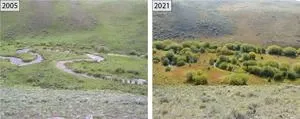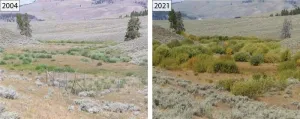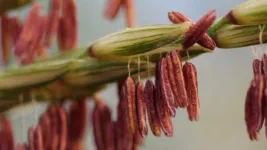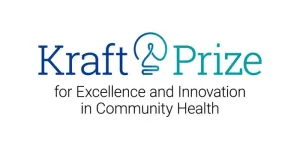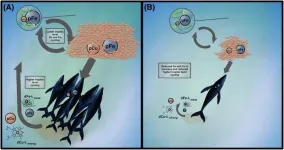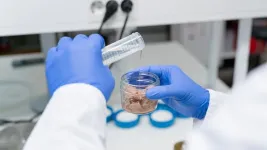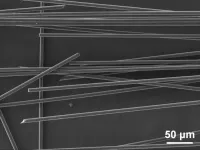(Press-News.org) AMES, Iowa – A farmer notices an unfamiliar insect on a leaf.
Is this a pollinator? Or a pest? Good news at harvest time? Or bad? Need to be controlled? Or not?
That farmer can snap a picture, use a smartphone or computer to feed the photo into a web-based application called InsectNet and, with the help of machine learning technology, get back real-time information.
“The app identifies the insect and returns a prediction of its taxonomic classification and role in the ecosystem as a pest, predator, pollinator, parasitoid, decomposer, herbivore, indicator and invasive species,” said a scientific paper describing InsectNet recently published by the journal PNAS Nexus. Iowa State University’s Baskar Ganapathysubramanian and Arti Singh are the corresponding authors. (See sidebar for a complete list of authors.)
InsectNet – which is backed by a dataset of 12 million insect images, including many collected by citizen-scientists – provides identification and predictions for more than 2,500 insect species at more than 96% accuracy. When the application isn’t sure about an insect, it says it is uncertain, giving users more confidence when it does provide answers.
And, because the application was built as a global-to-local model, it can be geographically fine-tuned using expert-verified local and regional datasets. That makes it useful to farmers everywhere.
So, beware, armyworms, cutworms, grasshoppers, stink bugs and all the other harmful insects. And, hello, butterflies, bees and all the other pollinators. Good to see you, lady beetles, mantises and all the other pest predators.
“We envision InsectNet to complement existing approaches, and be part of a growing suite of AI technologies for addressing agricultural challenges,” the authors wrote.
A village of researchers
InsectNet’s ability to be fine-tuned for specific regions or countries make it particularly useful, said Singh, an associate professor of agronomy.
In Iowa, for example, Singh said there are about 50 insect species particularly important to the state’s agricultural production. To identify and provide predictions about those insects, Singh said the project used about 500,000 insect images.
That could happen for farmers all over the globe. And wherever there isn’t sufficient data – these sophisticated models often require millions of images – for local fine-tuning, the global dataset is still available for farmers.
InsectNet isn’t just for farmers, though. Singh said it could also help agents at ports or border crossings identify invasive species. Or it could help researchers working on ecological studies.
So, the app is usable and flexible. But is it accessible?
You can’t go to an app store and download a version just yet, said Ganapathysubramanian, the Joseph and Elizabeth Anderlik Professor in Engineering and director of the AI Institute for Resilient Agriculture based at Iowa State. But the app is running on a server at Iowa State. With a QR code (see sidebar) or this URL (insectapp.las.iastate.edu/), users can upload insect pictures and get an identification and prediction.
This works throughout the stages of an insect’s life: from egg to larva to pupa to adult. It works with look-alike species. And it works with diverse image qualities and orientations.
The bottom line for any user is basic information about an insect: “Is this a pest?” Singh said. “Or is it a friend?”
Developers demonstrated the app during last August’s Farm Progress Show in Boone, Iowa. And now the research paper is introducing it to a broader, scientific audience.
But aren’t there already apps that help identify insects?
Yes, said Ganapathysubramanian, but they’re not to the scale of InsectNet and aren’t capable of global-to-local applications. And they’re also not open-source applications with technology that can be shared.
“Making InsectNet open source can encourage broader scientific efforts,” he said. “The scientific community can build on these efforts, rather than starting from scratch.”
The project also answered a lot of technical questions that could be applied to other projects, he said.
How much data is enough? Where can we get that much data? What can we do with noisy data?
How much computer power is necessary? How do we deal with so much data?
“Lastly, it takes a village of expertise to get to this point, right?” said Ganapathysubramanian.
It took agronomists and computer engineers and statisticians and data scientists and artificial intelligence specialists about two years to put InsectNet together and make it work.
“What we learned working with insects can be expanded to include weeds and plant diseases or any other related identification and classification problem in agriculture,” Singh said. “We’re very close to a one-stop shop for identifying all of these.”
– 30 –
Read the paper
“InsectNet: Real-time identification of insects using an end-to-end machine learning pipeline,” PNAS Nexus, Dec. 27, 2024, https://doi.org/10.1093/pnasnexus/pgae575.
Paper co-authors are:
Iowa State University
Shivani Chiranjeevi (first author)
Mojdeh Saadati
Talukder Z. Jubery
Daren Mueller
Matthew E. O’Neal
Asheesh K. Singh
Soumik Sarkar
Arti Singh (corresponding author)
Baskar Ganapathysubramanian (corresponding author)
Carnegie Mellon University
Jayanth Koushik
Aarti Singh
University of Arizona
Zi K. Deng
Nirav Merchant
Funding
The InsectNet project was supported by the U.S. Department of Agriculture’s National Institute of Food and Agriculture (through the AI Institute for Resilient Agriculture), the National Science Foundation (through COALESCE: COntext Aware LEarning for Sustainable CybEr-Agricultural Systems), the NSF’s Smart and Connected Communities Program, the USDA’s Current Research Information System Project, and Iowa State’s Plant Sciences Institute.
END
InsectNet technology identifies insects around the world and around the farm
2025-02-06
ELSE PRESS RELEASES FROM THIS DATE:
Restoring predators, restoring ecosystems: Yellowstone wolves and other carnivores drive strong trophic cascade
2025-02-06
Restoring Predators, Restoring Ecosystems: Yellowstone Wolves and other Carnivores Drive Strong Trophic Cascade
Corvallis, OR — February 6, 2025 — A new study reveals the profound ecological effects of wolves and other large carnivores in Yellowstone National Park, showcasing the cascading effects predators can have on ecosystems. In Yellowstone, this involves wolves and other large carnivores, elk, and willows. The research, which utilized previously published data from 25 riparian (streamside) ...
Corn’s ancient ancestors are calling
2025-02-06
The domestication of maize is one of the greatest examples of humankind’s impact on evolution. Early farmers’ pre-industrial plant breeding choices turned corn from a nearly inedible crop into the major global food source it is today.
Now, Cold Spring Harbor Laboratory Professors Rob Martienssen and Thomas Gingeras are uncovering the genetics behind choices farmers made 9,000 years ago. They aim to better understand how evolution works and to help today’s farmers update corn so it can grow in harsh conditions. To ...
Mass General Brigham’s Kraft Center Announces the 2025 Kraft Prize for Excellence and Innovation in Community Health
2025-02-06
Boston, MA – Today, the Kraft Center for Community Health at Mass General Brigham announced the launch of the inaugural Kraft Prize for Excellence and Innovation in Community Health. This national prize seeks to honor a transformative organization, program or innovation that is making a measurable impact on health outcomes and has the potential to become a scalable model for addressing community health.
“We established The Kraft Center for Community Health with a mission to expand access to high-quality, cost-effective healthcare for medically underserved patients, families, and communities,” ...
Whale poop contains iron that may have helped fertilize past oceans
2025-02-06
The blue whale is the largest animal on the planet. It consumes enormous quantities of tiny, shrimp-like animals known as krill to support a body of up to 100 feet (30 meters) long. Blue whales and other baleen whales, which filter seawater through their mouths to feed on small marine life, once teemed in Earth’s oceans. Then over the past century they were hunted almost to extinction for their energy-dense blubber.
As whales were decimated, some thought the krill would proliferate in predator-free waters. But that’s not what happened. Krill populations dropped, too, and neither population has ...
Mercury content in tuna can be reduced with new packaging solution
2025-02-06
Fish is a high-quality source of protein, containing omega-3 fatty acids and many other beneficial nutrients. However, the accumulation of toxic mercury also makes fish consumption a concern, of which tuna is particularly susceptible. Researchers from Chalmers University of Technology in Sweden have come up with a novel approach to packaging canned tuna infused in the water-based solution of amino acid cysteine. It was shown to remove up to 35 percent of the accumulated mercury in canned tuna, significantly reducing human exposure to mercury via food.
Fish and other seafood, provide people with a broad variety of essential nutrients in their diet However, the consumption ...
Recycling the unrecyclable
2025-02-06
Epoxy resins are coatings and adhesives used in a broad range of familiar applications, such as construction, engineering and manufacturing. However, they often present a challenge to recycle or dispose of responsibly. For the first time, a team of researchers, including those from the University of Tokyo, developed a method to efficiently reclaim materials from a range of epoxy products for reuse by using a novel solid catalyst.
There’s a high chance you are surrounded by epoxy compounds as you read this. They are used in electronic devices due to their insulating ...
Alien ocean could hide signs of life from spacecraft
2025-02-06
Searching for life in alien oceans may be more difficult than scientists previously thought, even when we can sample these extraterrestrial waters directly.
A new study focusing on Enceladus, a moon of Saturn that sprays its ocean water into space through cracks in its icy surface, shows that the physics of alien oceans could prevent evidence of deep-sea life from reaching places where we can detect it.
Published today (Thursday, 6 February 2025) in Communications Earth and Environment, the study shows how Enceladus's ocean forms distinct layers that dramatically slow the movement of material ...
Research unveils new strategies to tackle atrial fibrillation, a condition linked to stroke and dementia risks
2025-02-06
A recent Brazilian study published in Nature Cardiovascular Research has highlighted promising pathways for preventing and treating atrial fibrillation, a condition that significantly raises the risks of stroke and dementia. The research was led by the Federal University of Rio de Janeiro (UFRJ) in partnership with the D’Or Institute for Research and Education (IDOR).
What Is Atrial Fibrillation?
Atrial fibrillation (AF) is the most common cardiac arrhythmia worldwide. It disrupts the normal rhythm of the heart, causing irregular and often rapid heartbeats. This condition is associated with increased risks of stroke, dementia, and heart failure. It is also linked to other health ...
Research spotlight: Researchers identify potential drug targets for future heart failure therapeutics
2025-02-06
How would you summarize your study for a lay audience?
Heart failure remains a substantial burden for patients due to its high prevalence and limited therapeutic options. Heart failure is classified into two major clinical subtypes— heart failure with preserved ejection fraction (HFpEF) and heart failure with reduced ejection fraction (HFrEF). While there have been significant therapeutic advances in HFrEF, the rate of complications and death from HFrEF remains high. Additionally, most drugs that have shown benefits for patients with HFrEF have not demonstrated a comparable benefit in patients with HFpEF, highlighting a critical need for the development of targeted therapies ...
Air pollution clouds the mind and makes everyday tasks challenging
2025-02-06
People’s ability to interpret emotions or focus on performing a task is reduced by short-term exposure to particulate matter (PM) air pollution, potentially making everyday activities, such as the weekly supermarket shop, more challenging, a new study reveals.
Scientists discovered that even brief exposure to high concentrations of PM may impair a person’s ability to focus on tasks, avoid distractions, and behave in a socially acceptable manner.
Researchers exposed study participants to either high levels of air pollution - using candle smoke - or clean air, testing cognitive abilities ...


